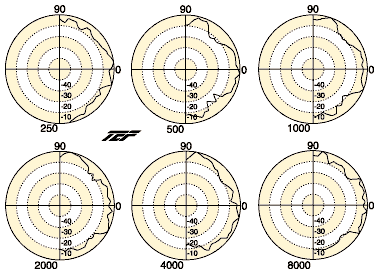Performance Data
All Products Master Data Table
Acoustical Testing Data
2" ProPanel ASTM C-423 A Mount Test Report
2" ProPanel ASTM C-423 Corner Mount Test Report
2" ProPanel + DST LENRD ASTM C-423 Corner Mount Test Report
1" Studiofoam Wedges ASTM C-423 Test Report
2" Studiofoam Wedges ASTM C-423 Test Report
3" Studiofoam Wedges ASTM C-423 Test Report
4" Studiofoam Wedges ASTM C-423 Test Report
2" Studiofoam Pyramid ASTM C-423 Test Report
4" Studiofoam Pyramids ASTM C-423 Test Report
2" Studiofoam Metro ASTM C-423 Test Report
4" Studiofoam Metro ASTM C-423 Test Report
2" Studiofoam Wedgies ASTM C-423 Test Report
1" SonoLite ASTM C-423 Test Report
2" SonoMatt ASTM C-423 Test Report
Sunburst (Male) ASTM C-423 Test Report
Sunburst (Female) ASTM C-423 Test Report
LENRD Bass Traps (A-Mount) ASTM C-423 Test Report
LENRD Bass Traps (J-Mount) ASTM C-423 Test Report
Venus 12" Bass Trap ASTM C-423 Test Report
Deep6 RAL ASTM 423 A Mount Test Report
Deep6 RAL ASTM 423 F Mount Test Report
Deep6 RAL ASTM 423 J Mount Test Report
SheetBlok ASTM E90-09 Sound Transmission Loss Test Report
SonoColumns ASTM C423 Test Report
SonoFlat ASTM C423 Test Report
SonoLite Bass Trap ASTM C423 Test Report
Studio6 (A Mount) ASTM C-423 Test Report
Studio6 (J Mount) ASTM C-423 Test Report
StudioDoor ASTM E-90 Acoustic Performance Test Report
T-Coustic Ceiling Tiles ASTM C423 Test Report
VersaTile Panels ASTM C423 Test Report
WaveCave™ Royale™ ASTM C423 Test Report
Master Bass Trap Testing Data
Bass Trap A-Mount Comparison Testing (Wall Mount)
Bass Trap J-Mount Comparison Testing (Corner Mount)
Section 9 Specifications
NRC Data Table
You can judge a foam’s absorptive effectiveness by studying its NRC (Noise Reduction Coefficient), a single number average of a foam’s absorption in what was determined long ago to be the most important range. The federally mandated test (ASTM C423) is standardized to cover frequencies between 125Hz and 4000Hz, but when calculating an NRC, only the coefficients from 250Hz to 2000Hz are used to help alleviate the possibility of testing errors.
All of our foam products are tested at an independent, unbiased acoustical laboratory – the oldest, most reliable lab in the country. We insist on using only the very best testing facility because we believe our customers deserve the most accurate absorption coefficient information possible.
| 125Hz | 250Hz | 500Hz | 1KHz | 2KHz | 4KHz | NRC | |
| 1" Studiofoam Wedges | 0.10 | 0.13 | 0.30 | 0.68 | 0.94 | 1.00 | 0.50 |
| 2" Studiofoam Wedges | 0.11 | 0.30 | 0.91 | 1.05 | 0.99 | 1.00 | 0.80 |
| 3" Studiofoam Wedges | 0.23 | 0.49 | 1.06 | 1.04 | 0.96 | 1.05 | 0.90 |
| 4" Studiofoam Wedges | 0.31 | 0.85 | 1.25 | 1.14 | 1.06 | 1.09 | 1.10 |
| 2" Studiofoam Pyramids | 0.13 | 0.27 | 0.62 | 0.92 | 1.02 | 1.02 | 0.70 |
| 4" Studiofoam Pyramids | 0.27 | 0.50 | 1.01 | 1.13 | 1.11 | 1.12 | 0.95 |
| 2" Studiofoam Metro | 0.13 | 0.23 | 0.68 | 0.93 | 0.91 | 0.89 | 0.70 |
| 2" SonoMatt | 0.13 | 0.27 | 0.62 | 0.92 | 1.02 | 1.02 | 1.05 |
| 2" Studiofoam Wedgies | 0.15 | 0.21 | 0.70 | 0.99 | 1.05 | 1.05 | 0.75 |
| 2" DST-114/244 | 0.16 | 0.29 | 0.57 | 0.75 | 0.90 | 1.00 | 0.65 |
| MAX-Wall Panels | 0.81 | 1.02 | 1.06 | 1.05 | 1.02 | 1.02 | 1.05 |
| VENUS Bass Traps | 1.63 | 1.34 | 1.29 | 1.26 | 1.25 | 1.20 | 1.30 |
| LENRD Bass Traps | 1.30 | 1.55 | 1.53 | 1.48 | 1.48 | 1.51 | 1.50 |
| 2" SonoFlat | 0.27 | 0.60 | 1.17 | 1.06 | 1.02 | 1.02 | 0.95 |
| Sunburst Males | 1.08 | 1.23 | 1.14 | 1.07 | 1.05 | 1.08 | 1.10 |
| Sunburst Females | 0.65 | 1.02 | 1.00 | 1.08 | 1.05 | 1.08 | 1.05 |
STC Data Table
STC (Sound Transmission Class), is a numerical rating of how effective a material is at blocking the transmission of sound through itself. This rating generally applies to hard materials like rubberized sound barriers, concrete, brick and drywall but also applies to a much lesser degree to softer materials like mineral fiber (although it isn’t tested by itself; it’s tested as part of a wall system to verify its effectiveness). Virtually every material filters out some of the sound that travels through it, but dense materials are much better at this than are spongy materials.
| Center Frequency | Transmission Loss |
| 125Hz | 17 |
| 250Hz | 17 |
| 500Hz | 22 |
| 1000Hz | 27 |
| 2000Hz | 32 |
| 4000Hz | 38 |
| Overall STC = 27 | |
Diffusors spread sound evenly over the entire hemisphere in front of it in both directions. The smoother the arc the better, because deviations from a smooth arc indicate volume changes. The object of diffusion is to redistribute mid and high frequency sound evenly throughout a space, not to absorb it, so you want a diffusor whose arcs at the various frequencies: (a) are very smooth, and (b) all show basically the same shape, which indicates the unit is providing uniform diffusion at all frequencies.
Diffusion Testing Data for GeoFusor & T'Fusor


